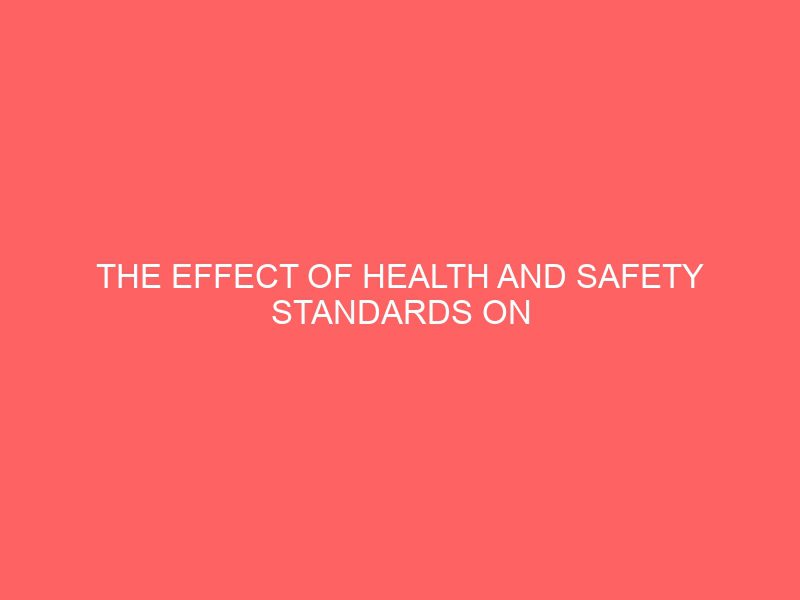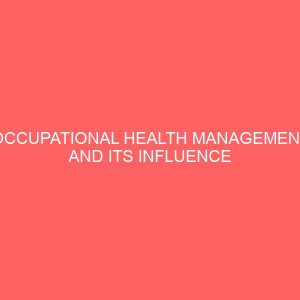Description
CHAPTER ONE
INTRODUCTION
This chapter entails the background of the study which captured health and safety standards on an organisation‟s productivity and how it can boost higher performance. The chapter also covers statement of the problem, purpose of the study, significance of the study, organization of the study and limitation of the study.
1.1 Background to the Study
Occupational health and safety is a process of ensuring that people stay safe and healthy in the workplace to increase workers capacity to perform. The workplace has become an integral part to the viability of business for employers, labor union, the society as well as the government. The quality of the workplace environment has an impact on the level of employees‟ motivation and performance. How well employees engage with the
organization, especially the immediate environment influences to a great extent their error rate, level of innovation and collaboration with other employees as well as absenteeism and ultimately affect the number of years they stay on the job. Health and safety standards instituted by organizations is aimed at the promotion and maintenance of the highest degree of physical, mental, social well being of workers in all sectors that have an impact on the health of employees.
In the globalized world, the relative edge of developing countries such as Ghana lies with the cost of labor. labor cost has become an important consideration in product and service development as most firms aim to maximize productivity from their workforce and equipment. Lehtinen, (2001) argued that health and safe working conditions improve productivity and will thus, help developing countries become competitive in the globalised world economy and that is why many organisations are making efforts to ensure that health and safety is managed at the work place effectively. According to Hughes, (2007), health is the protection of the body and mind of people from illness resulting from work. He also defined safety as a protection of people from physical injury. Hughes, (2007), however explained health and safety as, the welfare of people at work that is, the protection of facilities to maintain the health and well-being of individuals at the workplace. Safety hazards according to Cole, (2002), are those aspects of the work environment that have the potential of immediately causing violent harm to an employee whilst health hazards slowly and cumulatively lead to deterioration of an employee’s health.
Productivity is what people can produce at a given period with the least effort and resources. It is also a ratio that measures how well an organisation put resources into goods and services. Work environment can be seen as the circumstances, influences, stress, competitive, cultural, demographic, economic regulator and technological factors that affect the survival, operations and growth of an organisation.
According to Sundstrom et al, (1994), most people spend about seventy percent of their lives within the work environment which greatly influence their mental status, actions, abilities and performance. Better outcomes and increased productivity is assumed to be the result of better workplace environment. Alternatively, various literature pertaining to the study of the environment of work indicated that the factors such as dissatisfaction, cluttered workplaces and physical environment are playing a major role in the loss of employees‟ productivity (Carnevale, 1992).
The goal of organisations in instituting health and safety programs is to foster a safe and risk free work environment for the employees and the stakeholders at large to ensure efficiency of personnel and the end result to maximize productivity. Productivity has been an essential contributor to corporate success due to the fact that occupational health and safety has a direct translation of it into cost savings and profitability. An unsatisfactory work environment can have an adverse effect on worker motivation that tends to make minimal effort towards work thereby lowering performance.
The rubber firm is considered to be one of the most dangerous working environments for employees. Workers are exposed to hazards ranging from the use of chemicals, complex machines and working tools, odor, noise, factory waste, unguarded machinery, inadequate fire precautions and often, working under pressure for high productivity.
Health and Safety standard is very important in the manufacturing sector since a lot of employees have lost their lives whilst others have sustained various degrees of injuries through accidents. Although knowledge and experience are important parts of safe work and prevention of accidents, employees‟ aptitude and approach to work is also essential for ensuring a healthier working environment. According to Casio, (1996) it is easy to bypass the safe way to work but is often the precursor to an accident.
Industrial safety in Ghana is both a public and private issue. Manufacturing sector can be safe and enjoyable if employees follow the standardised procedures. It is regrettable that both employees and employers have demonstrated minimal commitment to reducing the level of accidents in the industry. Health and safety at the work place involve prevention or reduction of accidents and hazards such as injuries, material for production defects, equipment frequent breakdown, which affects production as well as the prevention of the employee‟s health problems such as emotional stress, lung diseases due to frequent inhaling of smokes, and so on. Employees are entitled to carry out their work in a safe environment, free from harm. However, in most times the basic right is violated due to a dearth of information on workplace health and safety standards. Individuals are often exposed to health and safety risks from their work. The International Labour Organisation, (2005) estimates that, some 6,000 workers die each day as a result of workrelated accidents or illness. The total cost of such accidents and ill health have been estimated by the International Labour Organisation to equal 4 per cent of global Gross Domestic Product. The traditional approach to safety in the workplace used the „careless worker‟ model. It was assumed by most organisations and the accident prevention bodies that most of the accidents were due to an employee‟s failure to take safety seriously whiles on the job.
Health and safety if put in place contribute to a good working environment as people spend most of their time at the workplace and so their working environment should be made safe, favorable and conducive to enhance a high level of productivity and to increase income for both the employer and employee. Good health at work helps improve employee’s health in general and also the productivity and competitiveness of businesses. Furthermore, workplace problems of health and safety exert a high cost for social protection systems and therefore workers need to be provided with suitable working conditions if their general wellbeing is to be enhanced. According to Stranks, (2000) all workers have a right to work in places where risks to their health and safety are properly controlled but due to poverty and illiteracy, people choose to work in any establishment or undertake any duty assigned in order to earn a living.
The main causes of injury in the selected firms for the study include slipping or tripping of employees on the work floors, machine related issues, exposure to noise, odor, dust as well as exposure to various chemicals. To this effect, employers have to take reasonable steps as a legal responsibility to ensure health, safety and welfare of their employees at work in order not to be found liable for any personnel injury. The employers responsibility to the employees include a duty to provide safe plant and machinery and safe working premises, a safe system of work and competent trained and supervised staff. Certain groups of employees may require more care and supervision than others for example disabled workers, pregnant workers and illiterate workers etc.
Workplace health and safety raises the question of economic costs. The economic cost of occupational health and safety to the organisation is double-edged. On the one hand, health and safety measures which protect employees from the hazards of the workplace can conflict with management’s objective of containing production costs. On the other hand, effective health and safety policies can improve the performance of employees and the organisation, by reducing costs associated with accidents, disabilities, absenteeism, or illness. There are also indirect costs associated with work-related accidents. The indirect costs include overtime payments necessary to make up for lost production, cost of retaining a replacement employee, a wage cost for the time spent by human resource manager personnel recruiting, selecting and training the new employee and, in less typical cases, the cost associated with loss of revenue on orders cancelled or lost if the accident causes a net long-term reduction on sales as well as the negative effect on morale in workers which may also lead to possible reduction in the quality of work (Rousseau, 1998).
Overall, the costs of most work-related accidents or illnesses to workers and their families and to employers are very high. On a national scale, the estimated costs of occupational accidents and illnesses can be as high as three to four per cent of a country’s gross national product. In reality, no one really knows the total costs of work-related accidents or diseases because there are a multitude of indirect costs which are difficult to measure besides the more obvious direct costs. Investment in safety prevention will lead to a significant decrease in occupational accidents and diseases which will also help save lives, prevent enormous human suffering and financial resources through employee absenteeism.
As Health and Safety standards play a vital role in working environment to reduce levels of occupational accidents and diseases, it relies on the cooperation of both employers and employees to ensure a „self-generating effort‟ between „those who create the risks and those who work with them‟ (Robbins, 2004). It is therefore important for organisations to treat every employee‟s complaint seriously and to ensure that they feel safe and healthy. A healthy and safe work environment helps to reduce costs and improve organisational effectiveness. If work-related illness and accidents can be transposed on to the balance sheet, the organisation can apply the same management effort and creativity to designing and maintaining a healthy and safe workplace as managers customarily apply to other facets of the business. As Robbins, (2004), stated „accident prevention can be integrated into the overall economic activity of the firm‟.
1.2 Statement of the Problem
In recent years some workers have temporarily or permanently been disabled by work related accidents as a result of inadequate safety knowledge on handling machines and equipment, neglecting to follow simple procedure in accomplishing task or management not providing the right safety standards and resources for employees.
Every business has the legal responsibility to ensure the health and safety of employees and other people affected by the business activities such as customers and suppliers. Poor health and safety practices lead to illness, accidents and significant cost to the business. Effective health and safety practices pay for themselves and improve the reputation organisations have with customers, regulators and the employees.
The human resource is one of the versatile resources an organisation depends on for production. Therefore, an effective and efficient use of the human resource will translate into the overall effectiveness and efficiency of the organisation. Although, many organisations accept the human resource as an important resource, they fail to realize that as part of their human resource management practices, there is the need for management to ensure that personnel in the organisation work in safe and healthy environment that will promote their optimum utilization. It should be emphasized that accidents are costly both to the affected worker and the organisation. Therefore, every effort should be made by management and employees in order to avoid occupational accidents from occurring.
Manufacturing is one of the most physically challenging environments employees do work. Workers encounter many hazards and other issues that compromise their safety such as excessive noise, operating on dangerous/complex machines and conditions that cause injury to employees. Casio, (1996) noted that machines and work environment have been the major causes of safety hazards. Most employees are less concerned about safety precautions at work, their cost, effect and benefit to themselves and the organisation as a whole. This is as a result of ignorance and negligence to safety measures and regulations instituted by the organisation.
Workers do not adhere to the precautionary measures put in place with the organisation such as wearing of personal protective equipment, machines usage, and inadequate system of delivery and storage of materials, inadequate information for task to be accomplished as well as poor level of understanding of health and safety policies put in place by the organisation. The effect of insufficient instructions on safety standards result in accidents leading to rampant loss of lives, injury and damages to properties. This has a negative impact on the organisation as employees are not motivated to do their best on the job that trigger performance. Thus, resources that would have been used to develop staff, given as incentives or alternatively expanding the business operations would be used in paying for medical bill, and hiring of temporary workers, paying for compensation and related court issues which also has its impact on the organisation.
Although Management and employees are making efforts to ensure safety in the workplace, accidents at the workplace keep on increasing which indicate that work environment is still unsafe. It is in this vein that the study has chosen to examine the effect of health and safety standards on the organisation‟s productivity in Ghana Rubber Estates Limited and how it can boost higher performance of employees and make recommendation on the health and safety of employees in the organisation.
1.3 Research Objectives
1.3.1 General objectives:
The main objective seeks to evaluate the effect of health and safety standards of employees on productivity.
1.3.2 Specific objectives:
The specific objectives of the study include to:
- identify health and safety standards in Ghana Rubber Estates Limited
- determine the effect of health and safety on employees‟ productivity.
- examine employees‟ level of understanding of health and safety policies of the organisation.
- assess the attitude of management towards the health and safety of employees.
- identify the challenges of health and safety standards in the organisation
1.4 Research Questions
The following research questions were used to achieve the objectives of the study.
These include;
1 What are the safety standards put in place in the organisation?
- How has health and safety standards affected employees‟ productivity?
- What is the level of employees understanding of health and safety policies of the organisation?
- What is the attitude of management towards health and safety of employees?
- What are the challenges of health and safety standards in the organisation?
1.5 Significance of the Study
One of the primary goals of organisations is to optimize human resource to achieve set targets. Issues of health and safety within organisations are critical in the accomplishment of tasks. Industrial accidents and illness make up one of the largest part of loss of production time in the industry and these injuries have posed a major challenge to most manufacturing industries. Companies have suffered long spells of production shortfalls, compensation payment, insurance premiums and legal battles due to injury, reduction to the quality of life, family problems and decrease of life-span and other effects which is impossible to evaluate its qualitative cost on the employee, organisation, society and the nation in general.
Health and safety of workers is a moral responsibility within our society that cannot only depend on productivity criteria within a particular company but can also have a serious consequence for individual workers, society and the nation as a whole. It is of the hope that the study would boost the morale of employees and ensure job security at all times by getting a better understanding of health and safety practices in the organisation. The study would also help the employees to comply with organisational health and safety standards which in the long run would reduce accidents and injuries at the workplace thereby increasing their performance and productivity.
This study would serve as the bases for increasing the awareness of health safety as well as identifying the weaknesses of the various strategies that employers adopt to enhance health and safety standards and recommend the possible ways of improving them. Employers would appreciate the cost of equipping employees with the right protective clothing and standards to ensure accident free environment.
Findings and recommendation offered should not only add to existing literature for academic purposes, but also provide useful insights and guidelines for enhancing the quality of health and safety among employees in organisations.
1.6 Limitation of the Study
As with many human endeavors, the study was not without any shortcomings. Some of the requirements in the questionnaire were sensitive company information and as such, employees and employers were reluctant in answering questions which was critical in providing the necessary response for the study as they were of the view that providing the right answers may affect them directly or indirectly.
1.7 Organisation of the Study
This dissertation is organized into five chapters. Chapter one presents the background to the study, problem statement, objectives (both general and specific). It also outlines the research questions, significance, as well as the limitations of the study. The second chapter reviews relevant literature on the concepts and core issues of the study while chapter three explains how the study was conducted. Methodological issues considered here include the study design, study population, sample size and sampling procedure and instrumentation, sources of data and procedure for data analysis and presentation. Chapter four discusses and analyzes the results of the study while chapter five summarizes, offers recommendations and conclusion for the study.








Reviews
There are no reviews yet.